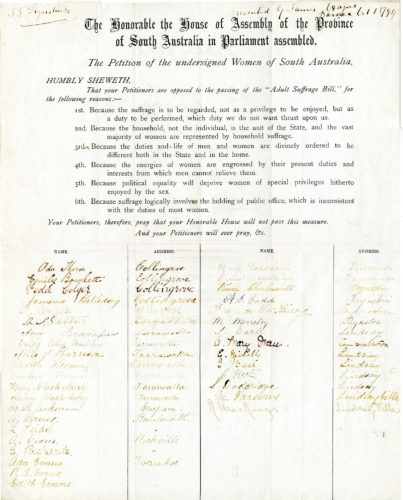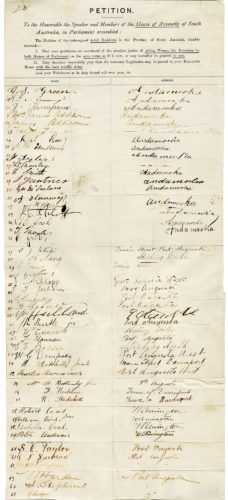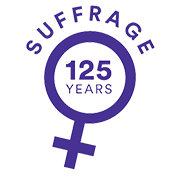What is a petition?
In a democracy a petition is a call to action. Petitions and petitioning were core strategies for the women’s suffrage movement in South Australia.
The South Australian Parliament explains that
“Petitioning Parliament is a long established fundamental right of all citizens. It allows any individual or group to place grievances before the Parliament. It is one of the few direct means of communication between the people and the Parliament.”[i]
Women’s Suffrage had it opponents and a petition tabled in the Legislative Council, and signed by fourty-four women attests to this. The petition was presented on Tuesday 14 August by the parliamentarian J.L. Stirling in response to the Adult Suffrage Bill. The petition claimed opposition on the following terms[ii]:
- Because the suffrage is to be regarded not as a privilege to be enjoyed, but a duty to be performed, which duty we do not want thrust upon us.
- Because the household, not the individual, is the unit of the State, and the vast majority of women are represented by household suffrage.
- Because the duties and life of men and women are divinely ordered to be different both in the State and in the home.
- Because the energies of women are engrossed by their present duties and interests, from which men cannot relieve them.
- Because political equality will deprive women of special privileges hitherto enjoyed by the sex.
- Because suffrage logically involves the holding of public office, which is inconsistent with the duties of most women.

Courtesy of the Speaker, House of Assembly, Parliament of South Australia
Just shy of 10 days later on 23 August another petition was tabled in Parliament, this time to the Legislative Assembly, by parliamentarian George Hawker, the then member for North Adelaide. This petition was much larger.
Signed by at least 11,600[iii] men and women from across the colony, from Kadina and Wallaroo to the South East of South Australia. This petition was “rolled up and tied with yellow ribbon”[iv], the colour of the Women’s Suffrage League in South Australia.

Courtesy of the Speaker, House of Assembly, Parliament of South Australia
The effort of collecting the many signatures was not solely that of the Women’s Suffrage League but also of the Working Women’s Trade Union and the Woman’s Christian Temperance Union who collected at least 8000 of the signatures of which many were form country areas.
The petition was a huge turning point in the debates, and we will hear more about those later this year.
You can search the petition online and discover if any of your relatives signed: https://www.centreofdemocracy.sa.gov.au/suffrage-petition/
Follow the hashtag #Suffrage125 throughout 2019 to learn more.
[i] Parliament of South Australia. (2019). accessed 24 July 2019. https://www.parliament.sa.gov.au/HouseofAssembly/BusinessoftheAssembly/RecordsandPapers/Documents/Petitions%20Information%20Sheet%20March%202014.pdf
[ii] Adelaide Observer. (1894). ‘Women’s Suffrage’. Saturday 18 August, Page 9.
[iii] South Australian Register. (1894). ‘House of Assembly’. Friday 24 August, Page 3.
[iv] Old Parliament House (State History Centre). 1994. ‘How a Parlaiment of Men Gave the Vote to Women’. Accessed 30 July 2019. https://www.parliament.sa.gov.au/education/teachers/Documents/How%20a%20Parliament%20of%20Men%20gave%20the%20Vote%20to%20Women.pdf






1 Comment
My great great grandmothers name is on that petition Emily Bridgman .. she had to bring up my nan after Nans daughter in law died and Nan told me stories, I clearly have activism in my blood and I’m so proud. Emily was also the area midwife helping mums deliver babies in Adelaide city where their little cottage still remans.